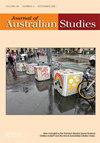Icons, Landmarks, Archives and Polls: Australian Studies Now
IF 0.4
3区 历史学
Q3 AREA STUDIES
引用次数: 0
Abstract
In another bumper issue of the Journal of Australian Studies, the expanse of Australian studies takes us from frontier history, crime narrative and visual culture through to questions of free speech, minority cultural identity, “larrikins” in Australian televisual culture, and feral horses. We are also pleased to offer an insight into current polling in the lead-up to the late 2023 referendum on the question of an Indigenous Voice to Parliament inscribed in the Constitution. The picture that emerges reflects the uncertain terrain of the referendum’s outcome, an extremely timely piece given the rancorous debate that surrounds it. Why are we drawn to seeing Big Things—oversized three-dimensional representations of everyday objects—when we travel around Australia? In the first article of this issue, “Making a Mark: Displays of Regional and National Identity in the Big Things of Australia and Canada”, Amy Clarke looks closely at these phenomena, which have attracted only minimal academic attention to date despite their pervasive presence across several countries. Sometimes dismissed as “lowbrow” or commercialised art forms, Big Things are, in fact, landmarks that can be investigated as material evidence of the identities and values of the communities— local, regional and national—who build, maintain and visit them. Clarke’s article takes a comparative approach to the 1,075 Big Things in Australia and 1,250 in Canada, revealing chronological, geographical and typological trends that highlight the capacity of these structures to represent their surrounding regions. In doing so, the article also demonstrates the value to be gained through studying Big Things as networks of meaning that evolve over time, reflecting the changing nature of their host societies. The cover image by Amos Gebhardt was chosen because it relates closely to Simon Farley’s contribution to this issue, “Mateship with Brumbies: Horses, Defiance and Indigeneity in the Australian Alps”. Farley notes that brumbies have occupied considerable space in settler-Australian culture since the 1890 publication of “The Man From Snowy River”. From the 1980s onwards, brumbies have been culled periodically to preserve “native” alpine ecosystems, which have not evolved to support hoofed animals. Such culls, however, are often highly controversial. Farley’s article leverages Sara Ahmed’s concept of affective economies to explain why the culling of brumbies generates such heated debate and intense public outpourings of emotion. The author relates the hyperaffective public performances of brumby supporters to a crisis in settler identity in Australia: as Indigenous activism has undermined the legitimacy of settler claims to belonging, some settlers have begun to use brumbies to assert their own kind of indigeneity. Linda Wells’s article, “Sarah Breaden: ‘A Refined and Splendid Kind of Girl’”, is based on her research into a collection of tin dwellings known as the Bungalow—located in the Northern Territory during the early 20th century. In the National Archives of Australia, Wells came across a file named “Sarah Breaden (Half Caste) Education”, which told a partial story of Breaden’s institutional life as a child of a Central Australian Aboriginal mother and a white father, who passed through the Bungalow at one time. Wells’s exploration of Sarah’s story, situated within a larger creative history of the first Bungalow in Alice Springs (1914–图标、地标、档案和民意调查:现在的澳大利亚研究
在另一期《澳大利亚研究杂志》上,澳大利亚研究的广阔范围将我们从边疆历史、犯罪叙事和视觉文化带到言论自由、少数民族文化认同、澳大利亚电视文化中的“larrikins”和野马等问题。我们也很高兴就2023年底就《宪法》中所载的土著向议会发出声音的问题进行全民公决之前的民意调查提供见解。浮现出来的画面反映了公投结果的不确定性,考虑到围绕公投展开的充满敌意的辩论,这是一篇非常及时的文章。当我们在澳大利亚旅行时,为什么我们会被“大东西”——日常物品的超大三维表现所吸引?在本期的第一篇文章《留下印记:澳大利亚和加拿大大事中的地区和国家身份表现》中,艾米·克拉克仔细研究了这些现象,尽管它们在几个国家普遍存在,但迄今为止只引起了很少的学术关注。“大事物”有时被视为“低俗”或商业化的艺术形式,但事实上,它们是地标性建筑,可以作为建造、维护和参观它们的当地、地区和国家社区的身份和价值观的物证进行调查。克拉克的文章对澳大利亚的1075个大事物和加拿大的1250个大事物进行了比较,揭示了时间、地理和类型的趋势,突出了这些结构代表其周围地区的能力。在此过程中,本文还展示了通过研究“大事物”作为随时间演变的意义网络所获得的价值,这些意义网络反映了其所在社会不断变化的性质。选择阿莫斯·格布哈特的封面图片是因为它与西蒙·法利对本期的贡献密切相关,“与布伦比的伙伴关系:澳大利亚阿尔卑斯山的马匹,反抗和土著”。法利指出,自1890年出版《来自雪河的人》(the Man From Snowy River)以来,布伦比在澳大利亚移民文化中占据了相当大的地位。从20世纪80年代开始,为了保护尚未进化到支持有蹄类动物的“原生”高山生态系统,人们定期捕杀熊。然而,这样的淘汰往往是极具争议的。法利的文章利用了萨拉·艾哈迈德的情感经济概念来解释为什么对布伦比的捕杀会引发如此激烈的辩论和强烈的公众情绪宣泄。作者将布伦比支持者的过度情感公开表演与澳大利亚定居者身份认同的危机联系起来:由于土著激进主义破坏了定居者主张归属感的合法性,一些定居者开始使用布伦比来维护自己的土著身份。Linda Wells的文章“Sarah Breaden:‘一个优雅而灿烂的女孩’”是基于她对20世纪初位于北领地的一组被称为平房的锡屋的研究。在澳大利亚国家档案馆,韦尔斯偶然发现了一份名为“萨拉·布雷登(半种姓)教育”的文件,其中讲述了布雷登在澳大利亚中部的一个土著母亲和一个白人父亲的孩子的机构生活的部分故事,他们曾经路过平房。威尔斯对莎拉故事的探索,位于爱丽丝泉第一个平房的更大的创作历史中(1914 -)
本文章由计算机程序翻译,如有差异,请以英文原文为准。
求助全文
约1分钟内获得全文
求助全文
来源期刊

Journal of Australian Studies
Multiple-
CiteScore
0.90
自引率
20.00%
发文量
56
期刊介绍:
The Journal of Australian Studies (JAS) is the journal of the International Australian Studies Association (InASA). In print since the mid-1970s, in the last few decades JAS has been involved in some of the most important discussion about the past, present and future of Australia. The Journal of Australian Studies is a fully refereed, international quarterly journal which publishes scholarly articles and reviews on Australian culture, society, politics, history and literature. The editorial practice is to promote and include multi- and interdisciplinary work.
 求助内容:
求助内容: 应助结果提醒方式:
应助结果提醒方式:


